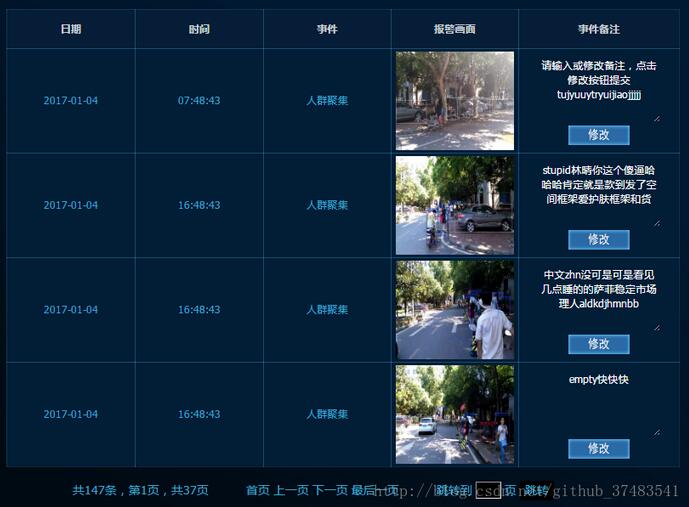使用ajax實現分頁技術
編輯:AJAX基礎知識
ajax分頁效果圖如下:

首先,先看 HTML 代碼和 CSS 代碼,我們需要一個 table 和一個 footer:
<div id="global"> <div id="table"> <table> <col width="19%"> <col width="19%"> <col width="19%"> <col width="19%"> <col width="24%"> <tr> <th>日期</th> <th>時間</th> <th>事件</th> <th>報警畫面</th> <th>事件備注</th> </tr> </table> </div> <div id="footer"> <span id="summary"></span> <ul id="pagination"> <li id="01">首頁</li> <li id="02">上一頁</li> <li id="03">下一頁</li> <li id="04">最後一頁</li> </ul> <div id="select"> <span>跳轉到 </span> <input type="text" name="page_num"> <span> 頁 </span> <input type="button" name="go_btn" value="跳轉"> </div> </div> </div>
下面是 css 代碼:
#global{
position: relative;
}
#table{
position: absolute;
top:19%;
left:1.6%;
width: 55%;
}
#table textarea{
width: 10vw;
height: 10vh;
background-color: transparent;
color: #fff;
border-width: 0;
text-align: center;
}
table, th, td {
border: 0.2px solid rgba(60,166,206,0.2);
border-collapse: collapse;
color:rgba(60,166,206,1);
}
th, td {
padding: 3px;
text-align: center;
font-size: 1.6vmin;
}
td{
background: rgba(2,29,54,1);
}
th{
background: rgba(20,29,54,1);
padding: 1.8% 0;
color: rgba(255,255,255,0.8);
}
#footer{
position: absolute;
bottom:5vh;
left:7vw;
text-align: center;
color: rgba(60,166,206,1);
}
#pagination{
display: inline-block;
}
#pagination li{
display: inline;
}
#select{
display: inline-block;
margin-left: 40px;
}
#select input[type="text"]{
width: 30px;
height: 20px;
background-color: #000;
border-width: 1px;
}
#select input[type="button"]{
width: 40px;
height: 23px;
background: #000;
border:none;
}
ul li{
cursor: pointer;
}
初始化開始日期,結束日期,請求的頁數,請求的每頁數量,總共有多少頁數據,並通過 ajax 將這些數據傳給後台提供的 API 數據接口,進而從數據庫中獲取到數據,然後可以在前端展示:
var start_date = "2017-01-01", end_date = "2017-01-08"; var pageNo = 1; var pageSize = 4; var pages = 0;
如何獲取表格的數據並將其 append 到前端?如何獲取分頁的數據並將其 append 到前端?使用下面我們定義的函數:
loadData(pageNo, pageSize);
接下來看這個函數如何跟 API 數據接口溝通:
function loadData(pageNo, pageSize){
$(".detail").remove(); //每次重新從 API 數據接口獲取數據都要先清除原先表格 `<tr>` 的內容
$.ajax({
url: "/history_alarm",
type: "POST",
data: JSON.stringify({date:date, page_num:pageNo, page_size:pageSize}),
success:function(result){
var results = JSON.parse(result);
var list = results.alarm;
var totalCount = results.alarm_count;
pages = results.page_count;
if(list.length != 0){
for(var i=0; i<list.length; i++){
var alarm_id = list[i].alarm_id;
var alarm_pic = list[i].alarm_pic;
var date = list[i].date;
var event = list[i].event;
var time = list[i].time;
var remark = list[i].remark;
appendData(alarm_id, alarm_pic, date, event, time, remark);
addEvent(alarm_id);
}
$("#table").show();
$("#footer").show();
displayFooter(totalCount, pages, pageNo);
} else{
$("#table").hide();
$("#footer").hide();
}
},
error:function(){
//error handle function
}
});
}
在 loadData 這個函數中我們還定義了另外3個函數,接下來我們先來看 appendData:
//注意到我們將 `alarm_id` 作為 `<textarea>` 'class` 的值,也作為提交按鈕 `id` 的值,這是因為我們要通過 ajax 將用戶輸入到某一個 `<textarea>` 的值作為參數傳給後台 API 接口,由其寫入數據庫。
function appendData(alarm_id, alarm_pic, date, event, time, remark){
var text = '<tr class="detail"><td>'+date+'</td><td>'+time+'</td<td>'+event+'</td>'+
'<td><img class="img01" src=data:image/jpeg;base64,' + alarm_pic + '</td>'+
'<td class="modity_btn"><textarea cols="5" rows="3"
class='+alarm_id+'>'+remark+'</textarea>'+'<img id='+alarm_id+' src="{{
static_url("slice/modify.png") }}"></td></tr>';;
$("#table table").append(text);
}
//該函數定義了如何通過 ajax 將用戶輸入到某一個 `<textarea>` 的值作為參數傳給後台 API 接口,並寫入數據庫
function addEvent(alarm_id){
$("#"+alarm_id).click(function(){
var remark = $("."+alarm_id).val();
if(remark != ""){
$.ajax({
url:"/history_alarm",
type:"POST",
data:JSON.stringify({alarm_id:alarm_id, note:remark}),
success:function(result){
var results = JSON.parse(result);
if(results.status == "ok"){
console.log('ok');
}
}
})
}
})
}
function displayFooter(totalCount, pages, pageNo){
var newText = '共' + totalCount + '條,' + '第' + pageNo + '頁,' + '共' + pages + '頁';
$("#summary").text(newText);
}
獲取數據的函數寫好了,接下來就要點擊分頁的“首頁、上一頁、下一頁、最後一頁、跳轉”時候所對應的事件了。思路是這樣的:用戶點擊分頁的每一個項目,都要重新判斷 pageNo,然後將 pageNo 作為參數,再次調用獲取數據的 API 接口:
$("input[name='page_num']").keydown(function(e){ if(e.keyCode == 13){ $("input[name='go_btn']").click(); } });
$("input[name='go_btn']").click(function(){
var goPage = $("input[name='page_num']").val();
if(goPage >= 1 && goPage <=pages && goPage != pageNo){
pageNo = goPage;
loadData(pageNo, pageSize);
} else{
return false;
}
});
$("#01").click(function(){
pageNo = 1;
loadData(pageNo, pageSize);
});
$("#04").click(function(){
pageNo = pages;
loadData(pageNo, pageSize);
});
$("#02").click(function(){
if(pageNo == 1){
return false;
} else{
pageNo--;
loadData(pageNo, pageSize);
}
});
$("#03").click(function(){
if(pageNo == pages){
return false;
} else{
pageNo++;
loadData(pageNo, pageSize);
}
});
以上就是本文的全部內容,希望對大家的學習有所幫助,也希望大家多多支持。
- 上一頁:ajax無刷新評論功能
- 下一頁:Ajax入門學習教程(一)
小編推薦
熱門推薦